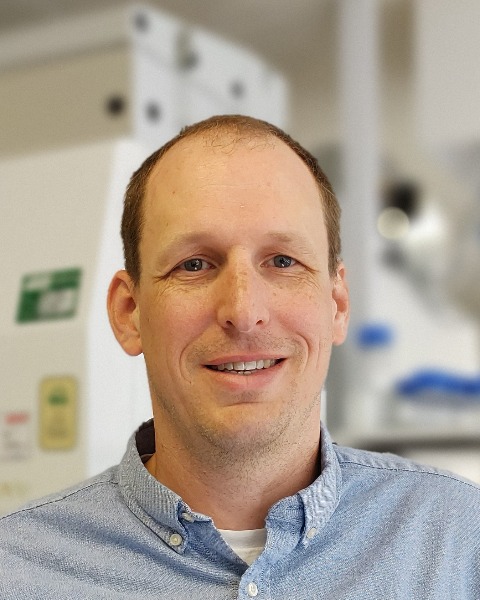Myeloma Novel Drug Targets and agents
Poster Session 2
P-190: Potent pre-clinical activity of EP300/CBP bromodomain inhibitor CCS1477 in multiple myeloma
Thursday, September 28, 2023
12:30 PM - 1:30 PM EEST

Kris Frese, PhD
Director of Cancer Biology
CellCentric Ltd
Cambridge, England, United Kingdom
Introduction: CCS1477 (also known as inobrodib) is a potent and selective inhibitor of the bromodomains of EP300 and CBP, two homologous histone acetyltransferases with critical roles in cellular growth and differentiation. CCS1477 has demonstrated potent anti-tumour activity against a variety of solid and haematological malignancies.
Methods: The in vitro activity of CCS1477 was assessed via cell viability assays in a panel of cell lines, including 12 human multiple myeloma cell lines. The in vivo efficacy of CCS1477 was assessed using a range of doses up to 20mg/kg daily in an OPM-2 human myeloma cell line NOD-SCID xenograft model. RNAseq was used to assess the transcriptional effects of CCS1477, and ChIPseq was used to identify drug-induced changes in EP300/CBP chromatin binding, H3K27 acetylation, and chromatin accessibility.
Results: In preclinical analyses CCS1477 induces potent growth inhibition through inducing cell cycle arrest at low nanomolar concentrations (GI50 < 100nM) in myeloma cell lines, including lenalidomide refractory lines. In vivo, there was dose-dependent inhibition of tumour growth, with high doses eliciting tumour regression and sustained inhibition of tumour growth for two weeks beyond the end of treatment.
RNA sequencing revealed substantial down regulation of transcription factor genes including MYB, MYC, IRF4, E2F1 and FOXM1; and GSEA showed significant enrichment among down regulated genes of gene sets associated with both MYC and E2F targets, consistent with drug-induced proliferative arrest. ChIP sequencing showed that EP300 and CBP binding peaks affected by CCS1477 were predominantly distributed over transcription factor binding motifs for IRF, Runt, bHLH, bZIP and MYB/SANT factor classes, and that loss of EP300/CBP correlated with a corresponding decrease in H3K27Ac. CCS1477 treatment induced a localized but significant reduction of EP300/CBP recruitment to intronic FGFR3 sites; FGFR3 is placed under the control of the active IGH promoter in the intergenic t(4;14) in OPM-2 cells. By 48 hours, in keeping with CCS1477-induced inactivation of IRF4 (a critical regulator of plasma cell differentiation required for myeloma cell growth) there was extensive genome-wide redistribution of EP300 binding away from sites with IRF4 motifs, while sites with other motifs remained occupied.
Conclusions: CCS1477 treatment rapidly alters EP300/CBP chromatin occupancy and subsequent gene expression programs, resulting in potent anti-tumour activity in multiple myeloma cells. These encouraging data provide a strong rationale for the ongoing phase I/IIa clinical trial investigating the safety and efficacy of CCS1477 in advanced haematological malignancies (NCT04068597), and provide mechanistic insight into the activity of CCS1477 against multiple myeloma.
Methods: The in vitro activity of CCS1477 was assessed via cell viability assays in a panel of cell lines, including 12 human multiple myeloma cell lines. The in vivo efficacy of CCS1477 was assessed using a range of doses up to 20mg/kg daily in an OPM-2 human myeloma cell line NOD-SCID xenograft model. RNAseq was used to assess the transcriptional effects of CCS1477, and ChIPseq was used to identify drug-induced changes in EP300/CBP chromatin binding, H3K27 acetylation, and chromatin accessibility.
Results: In preclinical analyses CCS1477 induces potent growth inhibition through inducing cell cycle arrest at low nanomolar concentrations (GI50 < 100nM) in myeloma cell lines, including lenalidomide refractory lines. In vivo, there was dose-dependent inhibition of tumour growth, with high doses eliciting tumour regression and sustained inhibition of tumour growth for two weeks beyond the end of treatment.
RNA sequencing revealed substantial down regulation of transcription factor genes including MYB, MYC, IRF4, E2F1 and FOXM1; and GSEA showed significant enrichment among down regulated genes of gene sets associated with both MYC and E2F targets, consistent with drug-induced proliferative arrest. ChIP sequencing showed that EP300 and CBP binding peaks affected by CCS1477 were predominantly distributed over transcription factor binding motifs for IRF, Runt, bHLH, bZIP and MYB/SANT factor classes, and that loss of EP300/CBP correlated with a corresponding decrease in H3K27Ac. CCS1477 treatment induced a localized but significant reduction of EP300/CBP recruitment to intronic FGFR3 sites; FGFR3 is placed under the control of the active IGH promoter in the intergenic t(4;14) in OPM-2 cells. By 48 hours, in keeping with CCS1477-induced inactivation of IRF4 (a critical regulator of plasma cell differentiation required for myeloma cell growth) there was extensive genome-wide redistribution of EP300 binding away from sites with IRF4 motifs, while sites with other motifs remained occupied.
Conclusions: CCS1477 treatment rapidly alters EP300/CBP chromatin occupancy and subsequent gene expression programs, resulting in potent anti-tumour activity in multiple myeloma cells. These encouraging data provide a strong rationale for the ongoing phase I/IIa clinical trial investigating the safety and efficacy of CCS1477 in advanced haematological malignancies (NCT04068597), and provide mechanistic insight into the activity of CCS1477 against multiple myeloma.
